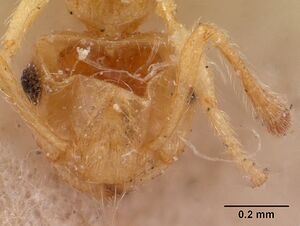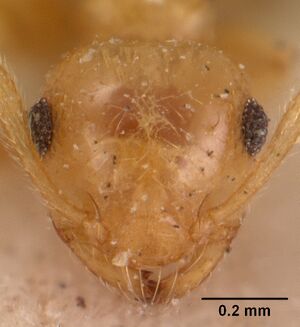Crematogaster madecassa
| Crematogaster madecassa | |
|---|---|

| |
| Scientific classification | |
| Kingdom: | Animalia |
| Phylum: | Arthropoda |
| Class: | Insecta |
| Order: | Hymenoptera |
| Family: | Formicidae |
| Subfamily: | Myrmicinae |
| Tribe: | Crematogastrini |
| Genus: | Crematogaster |
| Species: | C. madecassa |
| Binomial name | |
| Crematogaster madecassa Emery, 1895 | |
Crematogaster madecassa is fairly widespread throughout the rainforests and littoral forests of northern, eastern and southeastern Madagascar and is found up to medium elevations (highest record from 1175m). It occurs widely in sympatry with Crematogaster rasoherinae, and at a few localities also with Crematogaster volamena, Crematogaster mpanjono and Crematogaster telolafy. There is evidence that C. madecassa nests both on the ground and arboreally, as collections have been made from rotten logs, as well as from dead twigs above the ground. Intermediate workers are found in C. madecassa. (Blaimer 2012)
Identification
Blaimer (2012) - A member of the Crematogaster madecassa group. Workers of C. madecassa can be distinguished from all other species treated here except Crematogaster telolafy by the presence of two distinct vertical carinae on the clypeus. From workers of C. telolafy, C. madecassa workers are distinguishable by their longer, more spiniform propodeal spines and longer antennal scapes. Queens of C. madecassa can be easily identified from queens of most species (Crematogaster rasoherinae, Crematogaster volamena, Crematogaster mpanjono) by the presence of propodeal spines. C. madecassa queens can be distinguished from Crematogaster razana queens by the absence of a median clypeal notch (present in C. razana queens). Note however that queens of C. telolafy are currently unknown and could be very similar morphologically to C. madecassa queens.
Keys including this Species
Distribution
Latitudinal Distribution Pattern
Latitudinal Range: -12.26278° to -24.95167°.
| North Temperate |
North Subtropical |
Tropical | South Subtropical |
South Temperate |
- Source: AntMaps
Distribution based on Regional Taxon Lists
Malagasy Region: Madagascar (type locality).
Distribution based on AntMaps
Distribution based on AntWeb specimens
Check data from AntWeb
Countries Occupied
| Number of countries occupied by this species based on AntWiki Regional Taxon Lists. In general, fewer countries occupied indicates a narrower range, while more countries indicates a more widespread species. |

|
Estimated Abundance
| Relative abundance based on number of AntMaps records per species (this species within the purple bar). Fewer records (to the left) indicates a less abundant/encountered species while more records (to the right) indicates more abundant/encountered species. |

|
Biology
Castes
Males have yet to be collected.
Images from AntWeb
   
| |
| Worker. Specimen code casent0102053. Photographer April Nobile, uploaded by California Academy of Sciences. | Owned by MSNG, Genoa, Italy. |
    
| |
| Lectotype of Crematogaster madecassa. Worker. Specimen code casent0102054. Photographer April Nobile, uploaded by California Academy of Sciences. | Owned by MSNG, Genoa, Italy. |
   
| |
| Queen (alate/dealate). Specimen code casent0102137. Photographer April Nobile, uploaded by California Academy of Sciences. | Owned by MSNG, Genoa, Italy. |
   
| |
| Worker. Specimen code casent0173211. Photographer April Nobile, uploaded by California Academy of Sciences. | Owned by MHNG, Geneva, Switzerland. |
Nomenclature
The following information is derived from Barry Bolton's Online Catalogue of the Ants of the World.
- madecassa. Crematogaster sordidula var. madecassa Emery, 1895f: 342 (w.q.) MADAGASCAR.
- Type-material: lectotype worker (by designation of Blaimer, 2012b: 49), paralectotype workers (number not stated),
- [Note: the original syntype queen is not mentioned by Blaimer.]
- Type-locality: Madagascar: Diego Suarez, 1893 (Ch. Alluaud).
- Type-depository: MSNG.
- Combination in C. (Orthocrema): Wheeler, W.M. 1922a: 1024; Emery, 1922e: 131; Blaimer, 2012b: 32.
- Subspecies of sordidula: Wheeler, W.M. 1922a: 1024.
- Status as species: Emery, 1912e: 668; Emery, 1922e: 131; Bolton, 1995b: 157; Blaimer, 2012b: 49 (redescription).
- Distribution: Madagascar.
Unless otherwise noted the text for the remainder of this section is reported from the publication that includes the original description.
Description
Worker
Blaimer (2012) - (n=21) Lectotype worker: HW 0.54; HL 0.51; EL 0.13; SL 0.43; WL 0.54; SPL 0.13; PTH n.a.; PTL 0.17; PTW 0.16; PPL 0.10; PPW 0.17; LHT 0.40; CI 1.05; OI 0.26; SI 0.85; SPI 0.23; PTHI n.a.; PTWI 0.95; PPI 1.67; LBI 1.36.
Other material. HW 0.48–0.60; HL 0.43–0.51; EL 0.10–0.14; SL 0.37– 0.51; WL 0.44–0.63; SPL 0.08–0.14; PTH 0.09–0.14; PTL 0.14–0.22; PTW 0.12–0.22; PPL 0.09–0.14; PPW 0.13–0.21; LHT 0.33–0.52; CI 1.00–1.12; OI 0.22–0.27; SI 0.85–1.01; SPI 0.17–0.26; PTHI 0.55–0.72; PTWI 0.78–1.04; PPI 1.35–1.98; LBI 1.22–1.48.
Very small species (HW 0.48–0.60, WL 0.44–0.63), with characters of the C. madecassa-group, in addition to the following. Clypeus with two distinct median vertical carinae; antennal scapes well surpassing posterior margin of head.
Metanotal groove constricted to less than half as wide as pronotal width; propodeal spines medium-sized (SPI 0.17–0.26) and straight, usually thin and acute, in lateral view directed upwards, in dorsal view moderately diverging; subpostpetiolar process usually present, often as acute minute tooth.
Promesonotum usually with 6 erect, long flexuous setae: 2 humeral setae, and 2 setae each at anterior and posterior end of mesonotal carinae. Color pale to medium yellow.
Intermediate worker (n=2). HW 0.82–0.85, HL 0.73–0.78, EL 0.18–0.19, SL 0.55–0.59, WL 0.89–1.01, SPL 0.20, PTH 0.18–0.19, PTL 0.31–0.33, PTW 0.27–0.28, PPL 0.19, PPW 0.28–0.31, LHT 0.60, CI 1.09–1.12, OI 0.24, SI 0.75, SPI 0.20–0.22, PTHI 0.59, PTWI 0.86, PPI 1.46–1.66, LBI 1.48–1.68.
Intermediate between workers and queens in size. Head, petiole and postpetiole characters similar to queens; ocelli present, but smaller than in queens; mesonotum is to various extent raised and fused dorsally over pronotum and has wing attachment sutures; otherwise mesosomal characters more similar to worker characters.
Queen
Blaimer (2012) - (n=11) HW 0.87–1.03, HL 0.72–0.86, EL 0.24–0.32, SL 0.54–0.62, MSNW 0.66–0.92, MSNL 0.72–0.98, WL 1.28–1.53, SPL 0.06–0.21, PTH 0.19–0.26, PTL 0.38–0.49, PTW 0.30–0.39, PPL 0.21–0.28, PPW 0.34–0.42, LHT 0.65–0.81, CI 1.11–1.21, OI 0.29–0.37, SI 0.68–0.76, MSNI 1.55–1.87, SPI 0.04–0.14, PTHI 0.45–0.61, PTWI 0.68–0.91, PPI 1.42–1.69, LBI 1.87–2.08.
Very small (HW 0.87–1.03, WL 1.28–1.53), with characters of the C. madecassa-group, in addition to the following.
Mesosoma more compact (MSNI 1.55–1.87, WL 1.28–1.53), mesoscutum in dorsal view almost as wide as long; propodeal spines present, much shorter than in workers (SPI 0.04–0.14).
Type Material
Blaimer (2012) - (Museo Civico di Storia Naturale, Genoa). MADAGASCAR: Antsiranana: Diego-Suarez: [-12.26670, 49.28330] (Ch. Alluaud), CASENT0102053, CASENT0102054 and CASENT0101933. Lectotype worker by present designation: lower specimen of 2 workers on one pin, CASENT0102054 (image on AntWeb).
References
- Blaimer, B.B. 2012. Taxonomy and species-groups of the subgenus Crematogaster (Orthocrema) in the Malagasy region (Hymenoptera, Formicidae). ZooKeys, 199, 23-70.
- Blaimer, B.B., Fisher, B.L. 2013. Taxonomy of the Crematogaster degeeri-species-assemblage in the Malagasy region (Hymenoptera: Formicidae). European Journal of Taxonomy 51: 1-64 (doi:10.5852/ejt.2013.51).
- Emery, C. 1895g. Mission scientifique de M. Ch. Alluaud dans le territoire de Diego-Suarez (Madagascar-nord) (Avril-août 1893). Formicides. Ann. Soc. Entomol. Belg. 39: 336-345 (page 342, worker, queen described)
- Emery, C. 1912e. Beiträge zur Monographie der Formiciden des paläarktischen Faunengebietes. Teil XI. Dtsch. Entomol. Z. 1912: 651-672 (page 668, raised to species)
- Emery, C. 1922c. Hymenoptera. Fam. Formicidae. Subfam. Myrmicinae. [part]. Genera Insectorum 174B: 95-206 (page 131, raised to species)
- Fisher, B. L. 1997a. Biogeography and ecology of the ant fauna of Madagascar (Hymenoptera: Formicidae). J. Nat. Hist. 31: 269-302 (see also)
- Wheeler, W. M. 1922k. Ants of the American Museum Congo expedition. A contribution to the myrmecology of Africa. IX. A synonymic list of the ants of the Malagasy region. Bull. Am. Mus. Nat. Hist. 4 45: 1005-1055 (page 1024, Combination in C. (Orthocrema), Variety of sordidula)
References based on Global Ant Biodiversity Informatics
- Blaimer B. B. 2012. Acrobat ants go global Origin, evolution and systematics of the genus Crematogaster (Hymenoptera: Formicidae). Molecular Phylogenetics and Evolution 65: 421-436.
- Blaimer B. B. 2012. Taxonomy and species-groups of the subgenus Crematogaster (Orthocrema) in the Malagasy region (Hymenoptera, Formicidae). ZooKeys 199: 23-70
- Blaimer B. B., B. L. Fisher. 2013. How much variation can one ant species hold? Species delimitation in the Crematogaster kelleri-group in Madagascar. PLoS ONE 8(7): e68082. doi:10.1371/journal.pone.0068082
- Blaimer B. B., and B. L. Fisher. 2013. Taxonomy of the Crematogaster degeeri-species-assemblage in the Malagasy region (Hymenoptera: Formicidae). European Journal of Taxonomy 51: 1-64.
- Fisher B. L. 1997. Biogeography and ecology of the ant fauna of Madagascar (Hymenoptera: Formicidae). Journal of Natural History 31: 269-302.
- Fisher B. L. 2003. Formicidae, ants. Pp. 811-819 in: Goodman, S. M.; Benstead, J. P. (eds.) 2003. The natural history of Madagascar. Chicago: University of Chicago Press, xxi + 1709 pp.
- Soulié J., and L. D. Dicko. 1965. La répartition des genres de fourmis de la tribu des "Cremastogastrini" dans la faune éthiopienne et malgache. Hymenoptera - Formicoidea - Myrmicidae. Ann. Univ. Abidjan Sér. Sci. 1: 85-106.
- Wheeler W. M. 1922. Ants of the American Museum Congo expedition. A contribution to the myrmecology of Africa. IX. A synonymic list of the ants of the Malagasy region. Bulletin of the American Museum of Natural History 45: 1005-1055

